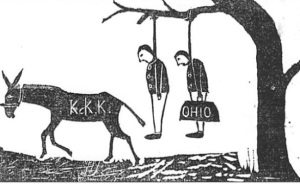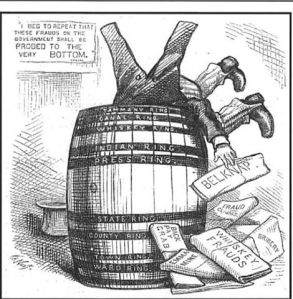1876 marked an important year in American history; that year marked the 100th anniversary of the Declaration of Independence and, ironically, the ending of Reconstruction. Although this year marked the 100th anniversary of a document symbolizing freedom, it also marked the end of civil rights for blacks. Reconstruction, by definition, is “the process by which the states that had seceded were reorganized as part of the Union after the Civil War” (from dictionary.reference.com). Reconstruction began directly after the Civil War’s close in 1865 and ended in 1877. A group known as Radical Republicans worked to help all freedmen gain rights, but white supremacist groups interfered. Despite the efforts of Radical Republicans, Reconstruction began to die down in America. Although both the North and the South played a role in ending Reconstruction, it was Southern intimidation and violence that was most responsible.
The North was not the leading reason Reconstruction ended, but the distracted and slightly racist attitude of Northerners contributed to it. Reconstruction was not the only problem in America during the 1860’s. Therefore, national issues became a hindrance to the government and restricted it from properly handling the situation. In an excerpt written by
Gerald Danzer, he explains how “many Northern voters shifted their attention to such national concerns as the Panic of 1873 and corruption in Grant’s administration” and as a result “the tide of public opinion in the North began to turn against Reconstruction policies” (C). Northern neglect was not intentional, but instead resulted from the multitudinous problems America was facing at the same time. The cartoon to the right is another source depicting Northern distraction. Ulysses Grant is portrayed diving into a barrel in an attempt to sort through all of the nation’s issues (C). The barrel is America and the act of Grant digging through it is metaphorical of sorting through the abundant troubles in the nation. At the same time, he cannot see anything beyond the barrel, which is symbolic of his distraction. Along with said distraction, there was lingering racism in the North. Even though the North was typically free of prejudice, there were traces of racism in Northerners. The Boston Evening Transcript, a pro-freedman newspaper, published a letter claiming that “the blacks, as a people, are unfitted for the proper exercise of political duties” (D). Blacks may have been free from slavery in the North, but they were not seen as equals and were not trusted to run in government. The picture to the right further proves Northern racism. This drawing was the cover of Harper’s Weekly and was made by a Northern artist (D). The black men are drawn with animal-like qualities to put the message across that black people are savages and cannot be trusted in government. Northerners may have contributed to the end of Reconstruction, but their distraction and racism was not as severe as the South’s actions.
North. Even though the North was typically free of prejudice, there were traces of racism in Northerners. The Boston Evening Transcript, a pro-freedman newspaper, published a letter claiming that “the blacks, as a people, are unfitted for the proper exercise of political duties” (D). Blacks may have been free from slavery in the North, but they were not seen as equals and were not trusted to run in government. The picture to the right further proves Northern racism. This drawing was the cover of Harper’s Weekly and was made by a Northern artist (D). The black men are drawn with animal-like qualities to put the message across that black people are savages and cannot be trusted in government. Northerners may have contributed to the end of Reconstruction, but their distraction and racism was not as severe as the South’s actions.
When compared to the North, the South appears extremely abusive and hostile; it was Southerner’s violence and harsh intimidation that were ultimately responsible for the end of Reconstruction. Not only was the South racist, like some Northerners mentioned above, but many Southerners acted on this racism in harsh ways. Acts of intimidation and violence in the South greatly affected the citizens and political activists working towards  Reconstruction, black and white alike. White supremacist groups, like the Ku Klux Klan, sparked fear into Southerners. One visual from the Independent Monitor depicts two white men being hung (A). One man is holding a carpet with “Ohio” written on it, to symbolize his position as a “carpetbagger” (A). A donkey with “KKK” written on its back symbolizes the driving force behind the hanging, the Ku Klux Klan. This picture was made to spark fear into the viewers, especially people from the North who moved South to support freedmen and Reconstruction. These people were known as carpetbaggers. A cartoon published in
Reconstruction, black and white alike. White supremacist groups, like the Ku Klux Klan, sparked fear into Southerners. One visual from the Independent Monitor depicts two white men being hung (A). One man is holding a carpet with “Ohio” written on it, to symbolize his position as a “carpetbagger” (A). A donkey with “KKK” written on its back symbolizes the driving force behind the hanging, the Ku Klux Klan. This picture was made to spark fear into the viewers, especially people from the North who moved South to support freedmen and Reconstruction. These people were known as carpetbaggers. A cartoon published in  Harper’s Weekly portrays another scene of intimidation; two white men are holding guns up to a black voter’s head with the hope of persuading him to vote for the Democrat candidate (B). The picture is accompanied by the caption, “Of Course he wants to vote the Democratic ticket” (B). In this situation, the white men are trying to end support of Radical Republicans and force blacks to vote for Democrats. On top of intimidation, violence was used by white supremacists to incite fear. The Ku Klux Klan used violence to persuade voters to choose Democrat candidates over Radical Republicans, as seen in the picture above. A testimony given by Abram Colby, a black elect to the Georgia State Legislature, demonstrates that the KKK targeted government officials as well. Colby testified, “On the 29th of October 1869, [the Klansmen] broke my door open, took me out of bed, took me to the woods and whipped me three hours or more and left me for dead” (B). The KKK used violence in hopes of influencing Colby to give up his position in office to a white man. This incident with Colby is an example of what blacks were exposed to daily while living in the South. White government officials were targeted as well. The North Carolina State Senator John Stephens was “stabbed five or six times , and then hanged on a hook in the Grand Jury room” (A). No one was safe from the wrath of the KKK in South. Regardless of race, white supremacists did everything in their power to prevent Reconstruction from continuing in America. Through the use of violence and intimidation, Southerners worked to run Radical Republicans out of government and end Reconstruction.
Harper’s Weekly portrays another scene of intimidation; two white men are holding guns up to a black voter’s head with the hope of persuading him to vote for the Democrat candidate (B). The picture is accompanied by the caption, “Of Course he wants to vote the Democratic ticket” (B). In this situation, the white men are trying to end support of Radical Republicans and force blacks to vote for Democrats. On top of intimidation, violence was used by white supremacists to incite fear. The Ku Klux Klan used violence to persuade voters to choose Democrat candidates over Radical Republicans, as seen in the picture above. A testimony given by Abram Colby, a black elect to the Georgia State Legislature, demonstrates that the KKK targeted government officials as well. Colby testified, “On the 29th of October 1869, [the Klansmen] broke my door open, took me out of bed, took me to the woods and whipped me three hours or more and left me for dead” (B). The KKK used violence in hopes of influencing Colby to give up his position in office to a white man. This incident with Colby is an example of what blacks were exposed to daily while living in the South. White government officials were targeted as well. The North Carolina State Senator John Stephens was “stabbed five or six times , and then hanged on a hook in the Grand Jury room” (A). No one was safe from the wrath of the KKK in South. Regardless of race, white supremacists did everything in their power to prevent Reconstruction from continuing in America. Through the use of violence and intimidation, Southerners worked to run Radical Republicans out of government and end Reconstruction.
The South was the main destructive force behind the close of Reconstruction, with some contributions from the North. Southern supremacists such as the Ku Klux Klan used intimidation and violence to spark fear into freedmen, Radical Republicans, and other supporters of Reconstruction. The North was less prominent in their corruption; it was their distraction and lingering racism that assisted in ending Reconstruction. Nevertheless, the South brimmed with voting pressure and supremacist violence towards all citizens supporting Reconstruction. Even if the North had not neglected the wrongdoings in the South, it would have taken a great amount of energy to stop the violence.
Bibliography
A
Albion Tourgee, Letter on Ku Klux Klan Activities. New York Tribune, May 1870.
Independent Monitor, September 1, 1868. Alabama Department of Archives and History, Montgomery, Alabama.
B
Abram Colby, testimony to a joint House and Senate Committee in 1872.
Harper’s Weekly, October 21, 1876.
C
Gerald Danzer et al., The Americans, McDougal Littell, 1998.
Harper’s Weekly, 1876.
D
Heather Cox Richardson, The Death of Reconstruction: Race, Labor and Politics in the Post-Civil War North, 1865-1901. Harvard University Press, Cambridge, Massachusetts, 2001.
Harper’s Weekly. March 14, 1874.
